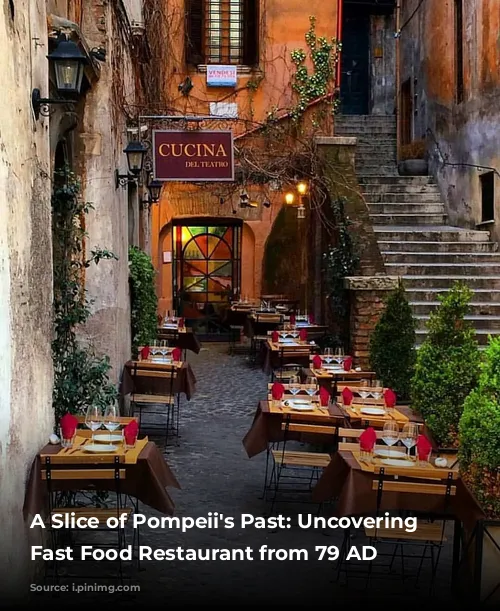Imagine stepping back in time to Pompeii, the ancient Roman city frozen in time by the eruption of Mount Vesuvius. Now, you can experience a glimpse of daily life in this lost civilization through a newly opened thermopolium – an ancient fast food joint!
This fascinating find offers a peek into the dietary habits and everyday routines of Pompeii’s inhabitants. While you can’t sample the honey-roasted rodents that were once considered a delicacy, you can marvel at the vibrant fresco paintings adorning the restaurant’s walls.
Culinary Delights and Daily Life
One fresco depicts a rooster, hinting at ingredients used in the thermopolium’s dishes. Another showcases a mythological scene with a Nereid riding a sea-horse, showcasing the artistry of the time. A third fresco displays a collared dog and an inscription that translates to “Nicias Shameless Shitter,” likely a cheeky insult directed at the owner, Nicias.
The discovery of this thermopolium in 2019 provided valuable insights into the diet and daily life of Pompeians. Experts believe food was displayed in large dolia jars, embedded in the stone counter – similar to modern-day takeout restaurants.
A Menu of Ancient Delights
Excavations have unearthed an array of bones: duck, pig, goat, fish, and even snail shells, hinting at a menu featuring meat and seafood stews. The thermopolium likely served salty fish, baked cheese, lentils, and spicy wine. Some jars even retained the strong scent of wine, offering a sensory experience of the past.
Pompeii’s Culinary Culture
The discovery of this thermopolium adds to our understanding of Pompeii’s culinary culture, a topic explored in the exhibition “Last Supper in Pompeii” at the Legion of Honor museum in San Francisco. The city’s sudden destruction preserved food and cookware, offering a snapshot of daily life.
A City’s Dining Habits
The thermopolium was a common sight in Pompeii – over 80 such establishments have been unearthed. This speaks volumes about the dining habits of Pompeii’s citizens. Poor families relied on these restaurants as they couldn’t afford kitchens in their homes. Wealthy families, on the other hand, preferred to have feasts prepared by enslaved workers in their richly decorated banquet halls.
A Glimpse into Regio V
The newly opened thermopolium is located in Regio V, a section of Pompeii that has been the focus of ongoing excavations since the 1960s. Besides the thermopolium, visitors can explore the Casa di Orione and Casa del Giardino mansions, offering a glimpse into the opulence of the city’s elite.
More Than Just Food
This area has also yielded other fascinating discoveries, including the skeleton of a man who likely perished while fleeing the volcano, as well as a collection of amulets that may have belonged to a female sorcerer. The thermopolium itself holds the skeletal remains of its proprietor, suggesting a tragic end to this once-bustling establishment.
Step back in time and experience a slice of Pompeii’s past through this newly opened thermopolium. Witness the culinary delights, the artistic frescoes, and the stories etched in stone – all remnants of a civilization frozen in time.
